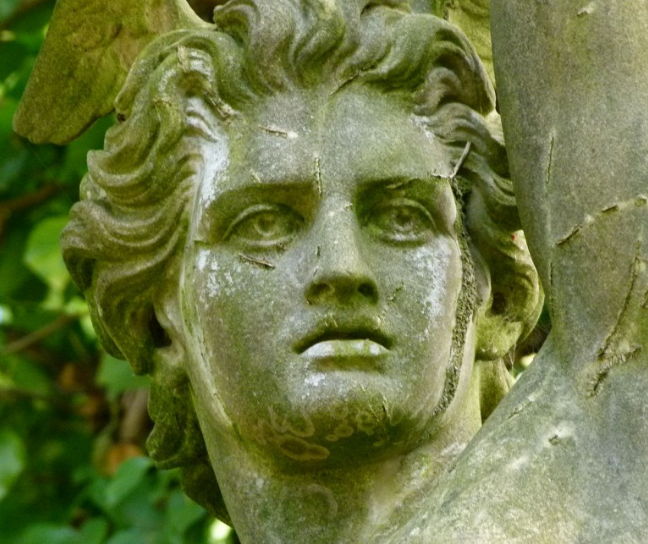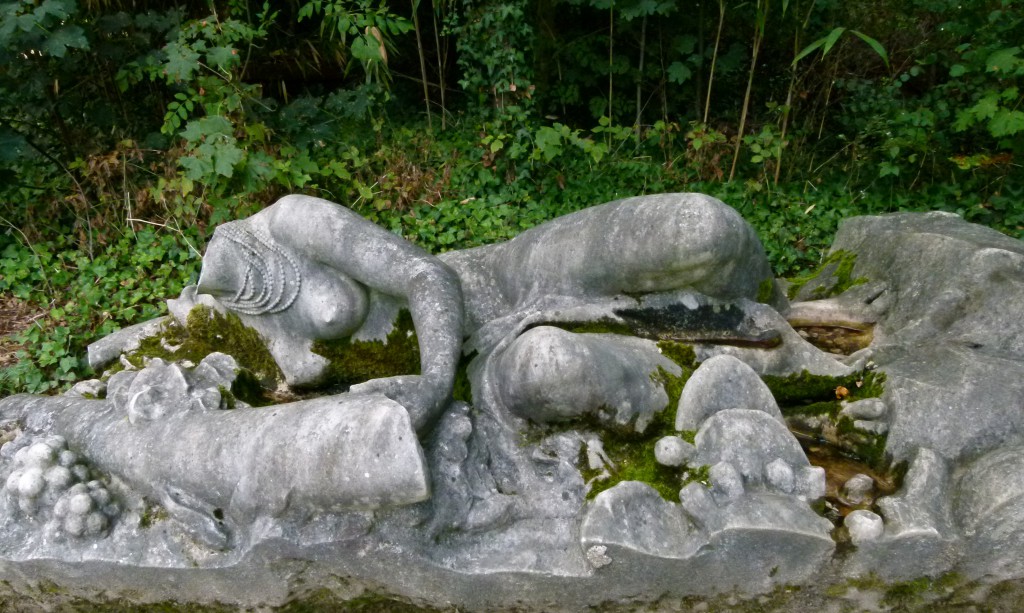
Unknown sculptor. Perseus and Medusa, Jardin d’Agronomie Tropicale.
On a rainy day in Paris, early this past January, we went looking for the ruins of the 1907 Colonial Exhibition. We didn’t look too closely at a map in advance. We knew that the fair had taken place near the park, Bois de Vincennes, on the city’s eastern outskirts. The ornate building nearest that park has been the Museum of the History of Immigration since 2007 but was originally erected as part of the 1931 Colonial Exhibition, a particularly indulgent affair where the victors of World War I built expensive pavilions to show off their prowess in their colonies. (Or at home: at the fair, the United States built a replica of Mt. Vernon.) Initially, the museum had been called the Permanent Colonial Exhibition. Then it became the Museum of French Overseas Dominion, and later, in 1960, the Museum of African and Oceanic Art. Surely, someone at this place would be able to tell us where to find the ruins we’d heard about.
But the guard at the museum couldn’t tell us, nor the woman at the information desk, nor the woman manning the coat-check. Perhaps we simply asked the wrong people, but the collective ignorance made some sense: we were in a museum whose multiple name changes reflect attempts to distance itself from its origins as a paean to colonization. If the museum’s staff-training sessions omitted references to the remains of a fair infamous for its human zoos—in which people from colonized cultures were on display—I would not be surprised.
Wandering around in the rain without direction did not appeal to us, so we returned the next day with two other friends. We’d done research this time, and we found the correct entrance to the Jardin d’Agronomie Tropicale. Marked by the kind of Oriental archways that often appear in Western Chinatowns, the entrance was manned by a guard who checks the bags of all visitors. I do not know if this bag-checking practice predates the high state of security the city entered after last year’s terrorist attacks, but the experience was peculiar. No one else was in sight when we entered, and the idea of anyone targeting a derelict memorial to France’s damaging past was surreal.
The Jardin d’Agronomie Tropicale opened to the public in 2006. Before that, it was untended and not actually owned by the city. In the ten years since, information signs have been updated and the Indochina Pavilion restored, so that it could be used for exhibitions or events. But the Moroccan Pavilion has broken windows, and the La Reunion Pavilion looks like it survived a fire (which it did). Journalists and bloggers pointed out the benefits of this partial restoration: the city could toe a line—not ignoring this history but not restoring it such that that it would seem condoned.
We visited out of curiosity but also with hope that our experience in the garden might inform our work. One fellow traveler has been exploring the way both personal and historical traumas become replicated. Another seeks and photographs embassies or other ideologically driven buildings, in an attempt to understand how place and power coincide. We are by no means the first creative individuals in recent years to discover and then become enamored with this garden.
The first artwork I encountered that was inspired by the 1907 ruins was a sculpture by the French conceptualist Pierre Huyghe. In 2014, he built a replica of a stone figure he had seen in the garden, of a reclining nude woman, now headless and surrounded by moss. Huyghe calls his sculpture La Deraison. I had seen it in person before I knew where it came from, and I questioned whether its damaged, overgrown qualities were enough to offset the objectification that it clearly once represented. Was Hughye participating in or subverting a problematic historical trend?
Also in 2014, the South African artist Brett Bailey, in what was left of one pavilion, gave an interview about his controversial project Exhibit B, a traveling human zoo modeled after those in 1907. “It’s about racism, in a nutshell,” he said. “It’s about how black and brown people have been represented in the West, as inferior…or barbaric to justify certain policies, and the history of colonialism and its impact on various African countries.”1 At the time, a Change.org petition was circulating, arguing that Bailey’s work perpetuated rather than upended aspects of the colonial legacy and should not be seen in Paris. Later, when his exhibition did open at the Gérard Philipe Theater, protesters became violent at the opening.
That it is difficult to understand and reverse the legacy of colonization is perhaps why the ruins are so compelling right now, at this moment when postcolonial is a familiar term but divides between East and West seem re-entrenched.

A sculpture in the Jardin d’Agronomie Tropicale that inspired Pierre Huyghe’s La déraison.
Before it became the site of the fair, in 1899, the garden served as a testing ground, where Parisian gardeners experimented with crops from the colonies (like cacao and coffee), to see what could survive in French soil. The day we visited, we walked a few times around the perimeter of the Tunisian Pavilion, a regal L-shape structure with a woven-wood lattice over its windows, for security. We also investigated the monument to the Black soldiers who died for France; then, thanks to the charm of one friend’s two small dogs, we befriended the gardener and agriculture scholar who now helms the onsite library. He agreed to let us briefly glimpse the archives. He had the ruddy face of someone who has worked under the sun and the office of an obsessed academic. He had books about French bureaucracy laid across his desk and a group of maps on a table nearby, including one of the 1931 Colonial Exhibition, of which few physical traces survive. That fair spurred a protest exhibition, by Surrealists and Communists who vehemently opposed such celebration of colonization.
About a week after our visit, during a visit to Lisbon, we mentioned the ruins to Milena Bolina, a Colombian artist based in Amsterdam. For a few years, she has been fascinated by chocolate, a product of the colonies, appropriated by the colonizer. She said she felt there was something in the air—that a number of artists were discussing the Jardin d’Agronomie Tropicale, trying to figure out how to interact with it. These projects, unlike those by Huyghe and Bailey, by and large haven’t been realized yet. With her collaborator, Luisa Ungar, Bolina has been preparing for a project about the garden. Currently they are researching: reading about the garden, mining images from ethnographic films, studying “derelicts of history” (writer Esther Leslie’s term), and reading about the “inner racist” in relation to human zoos.
The renewed interest in the garden perhaps has to do with its function as a metaphor: it is raggedly preserved, marginalized but not destroyed, a stand-in for a tension between the desire to understand and the desire to ignore a misguided past. There are bodies buried, literally, in the garden. Twenty-seven of the people on exhibit during the fair died there. Then, when the site became an infirmary for soldiers injured during World War I, more died there. How to excavate all this, and expose it in a way that captures its exceptionally shady truth, is the question.
1. Cutaia, Caroline. (Oct. 2013). « EXHIBIT B » / BRETT BAILEY. [Video File].



